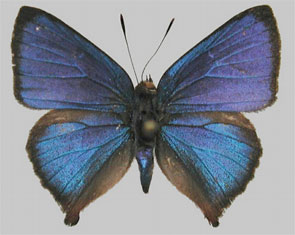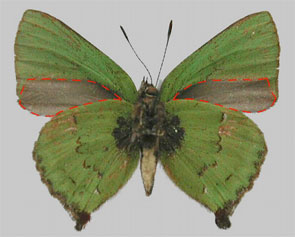| Posted: Sep 21, 2006 | |
Butterflies provide clues for replacing color pigments with photonic nanocrystals |
|
| (Nanowerk Spotlight) Photonic crystals are attractive optical materials for controlling and manipulating the flow of light. They can be engineered to produce a variety of optical filtering functions. The growing efforts of physicists and materials scientists to fabricate photonic (nano)crystals were motivated mainly by the potential application of these materials in optical computing, the manufacturing of more efficient lasers, and other exciting new phenomena, like those arising from the application of disturbances such as shock waves. | |
| The manufacturing of large-area photonic crystals operating in the visible spectrum is still a challenging and expensive task, given present-day laboratory techniques. However, as with so many other materials, nature has already found a solution. Because they are ready made, common in nature, and because they show a very high complexity, biological photonic-crystal structures will be an essential tool for building a useful knowledge of inhomogeneous optical media. | |
| A group of researchers in Hungary (Research Institute for Technical Physics and Materials Science) and Belgium (Facultés Universitaires Notre-Dame de la Paix Namur) examined the two faces (ventral and dorsal) of the Brazilian butterfly Cynophrys remus. The dorsal face, metallic blue, is clearly conspicuous, while the ventral face, a dull pea green is most probably inconspicuous in the green of the habitat, i.e. a cryptic color. | |
  |
|
| (left) Dorsal surface and (right) ventral surface of the butterfly Cyanophrys remus showing their structural colors. The region of the forewing delineated by dashed red lines is covered by the hindwings in resting position. (Source: Dr. Vigneron) | |
| "We showed that both were structural colors (from interferences, not pigments), so that it proves that light interference can produce dull colorations as well as bright metallic glances" Dr. Jean-Pol Vigneron, one of the researchers, explained to Nanowerk. "The way it happens is related to the amount of order and disorder found in the scales geometry, different on the ventral and dorsal faces: the dorsal face of the butterfly wings is made of scales which bear a single photonic monocrystal which spans the whole scale surface, very coherent, with both short-range and long-range orders; the ventral face has scales with many small photonic crystallites, with a few different orientations, providing a few distinct colors (yellow, green, blue-green) which mix to provide the optimized pea-green cryptic color found. The crystallites have short-range order, but the sizes and locations of the crystallites are somewhat random, providing a long-range disorder. This disorder leads to the dull appearance. The dull structural coloration is indeed surprising, because intuitively, structural, interferential origin has been generally related to bright metallic colors." | |
| Structural colors have been thought to always provide metallic or iridescent (i.e. changing with perspective) colors. This new research shows that dull colors could also be originating from interferences. | |
| This offers intriguing possibilities for materials engineers: In engineering photonic crystals, one tries to avoid disorder which cause diffusion rather than clear reflection and diffraction. Here the work suggests the use of "photonic polycrystals" to obtain controlled diffusion. | |
| "This suggests that one can achieve structurally, with transparent materials, the same effect as with pigments (diffuse scattering of light) and replace pigments by disordered structures" says Vigneron. "This may be important for the coloration of many materials, such as plastics, metals, and fibrous materials, like textiles and paper." | |
| The researchers point out that the way in which the color of the scales on the ventral wing surface is generated may give inspiration for "composing? practically any hue of colors from red, green, and blue RGB color palette photonic-crystal grains. Interesting practical transpositions may arise, if a structure is found which gives reflection in red, making possible in this way the use of an RGB color palette for artificial photonic crystal displays built of grains similar to those found on the dorsal surface scales of Cyanophrys remus. | |
| Building on these findings, Vigneron says it is important to try fabricating photonic polycrystals, with short-range order in crystallites and long-range disorder in the distribution of the crystallites to see what kind of color effects they can produce. | |
| A paper describing the findings ("Gleaming and dull surface textures from photonic-crystal-type nanostructures in the butterfly Cyanophrys remus"), appeared in the August 31, 2006 online edition of Physical Review E. | |
 By
Michael
Berger
– Michael is author of three books by the Royal Society of Chemistry:
Nano-Society: Pushing the Boundaries of Technology,
Nanotechnology: The Future is Tiny, and
Nanoengineering: The Skills and Tools Making Technology Invisible
Copyright ©
Nanowerk LLC
By
Michael
Berger
– Michael is author of three books by the Royal Society of Chemistry:
Nano-Society: Pushing the Boundaries of Technology,
Nanotechnology: The Future is Tiny, and
Nanoengineering: The Skills and Tools Making Technology Invisible
Copyright ©
Nanowerk LLC
|
Become a Spotlight guest author! Join our large and growing group of guest contributors. Have you just published a scientific paper or have other exciting developments to share with the nanotechnology community? Here is how to publish on nanowerk.com.
